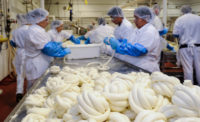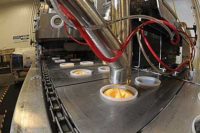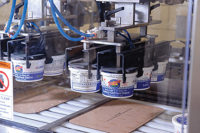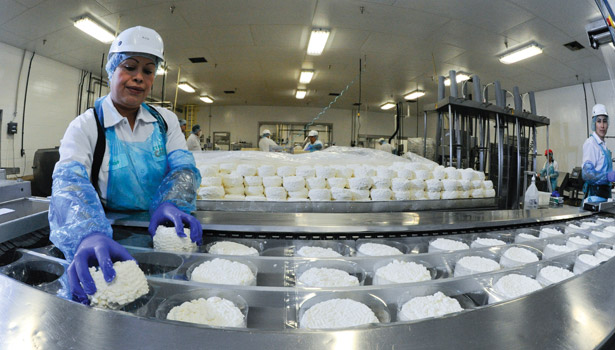A look inside California's Central Valley Cheese

Balls of cheese are placed in baskets and then will run through a vacuum sealer.

Milk has been pumped into a cheese vat and rennet added by hand at the Central Valley Cheese facility. After about 30 minutes, the curd is set and cut.

CEO Anto Baghdassarian insists on cleanliness in his cheese plant in Turlock, Calif.

A popular ethnic cheese is called yanni, which is a grilling cheese. Samples were prepared for Dairy Foods’visit.

Above and right: In 2007, Central Valley Cheese built a Grade A plant to produce yogurt and cultured dairy beverages. The company installed processing equipment, fermentation tanks, fillers and other related equipment.


The plant separates cream from skim. Central Valley Cheese also processes cup-set yogurts and drinkable yogurts, in addition to various fresh cheeses.

The cheese plant and the yogurt plant have their own pasteurizers and heat exchangers.

cheeses are vacuum-packed for retail distribution. The plant installed a smoker which can flavor 800 pounds of cheese at one time.

In 2007, Central Valley Cheese built a cultured dairy processing plant. Here, a filler fills cups with yogurt.

Central Valley Cheese performs a variety of tests on milk at various stages of production. The lab also tests work in progress and finished products.

Central Valley Cheese performs a variety of tests on milk at various stages of production. The lab also tests work in progress and finished products.

Central Valley Cheese receives rBST-free milk from Dairy Farmers of America. Milk is tested for antibodies in a lab in the receiving area.

The wall of fame in the office lobby shows off some of the awards won by Central Valley Cheese.














Have you heard about the Danish-educated Armenian immigrant from Lebanon who hired a Portuguese cheesemaker in California to produce paneerfor Indians? Actually, that’s not a joke, In a nutshell, that is the story of Anto Baghdassarian, the owner of Central Valley Cheese in Turlock, Calif.
Since coming to the United States in 1990, Baghdassarian has built a growing business that produces cheeses and cultured dairy products for various markets. From the beginning, it picked up mainstream American consumers who are seeking new foods and flavors.
The dairy products are formulated to appeal to the mainstream American palate, as well as Mediterranean, Hispanic, Indian and South Asian consumers. Customers are foodservice accounts, food processors and private label accounts.
The cheesemaker is right on trend by tapping into Americans’ interest in specialty foods and better-quality artisan cheeses. According to a report from the International Dairy-Deli-Bake Association, Madison, Wis., “as consumer palates evolve, so does the demand for specialty cheese and robust flavors.”
At its plant in Turlock, Central Valley Cheese makes labne (kefir cheese), feta, braided white cheese (unflavored, flavored with seeds and smoked), yanni (plain and spiced grilling cheeses), paneer, queso fresco, queso blanco and cotija. Cultured dairy products include plain yogurt (whole milk, low-fat and nonfat) in retail and bulk containers, Greek-style yogurt, sour cream, labne and yogurt drinks including mango lassi (popular with Indians).
Jim Dimataris, the director of processor relations for the California Milk Advisory Board, Sacramento, has known Baghdassarian for six years.
The company has grown from a small regional processor “to a major processing company,” Dimataris said. “They are a high-quality processor with a vision for how their products can fit not only into the specialty stores but also in the mainstream markets.”
Owner and CEO Baghdassarian is passionate about two things: food safety and quality. You can’t have one without the other. Food safety guides the company. He said “food safety is our moral responsibility and we are committed to provide our customers and consumers with high-quality safe foods.”
When he talks about consumers, Baghdassarian is thinking of his eight grandchildren. He would not serve them (or anyone else) anything but the cleanest, best-tasting foods. That is why plant employees make sure to thoroughly clean and sanitize each piece of equipment and related parts at the end of every production run. The air in the cheese and yogurt production areas is filtered and controlled by HVAC and HEPA systems.
So intense is the focus on cleanliness and food safety that employees re-sanitize cheese forms before a morning shift, even though the forms have gone through a washing machine the night before. “What if dust fell into the vat overnight?” Baghdassarian asks.
It is this attention to cleanliness and food safety detail that has resulted in the plant’s perfect score of 100 on the latest Interstate Milk Shippers report. The plant has also achieved BRC Level A status in 2013. A team of two auditors spent three days at the plant before issuing its report.
A hazard analysis and critical control points program is the foundation for Central Valley Cheese’ food safety system, Baghdassarian said. The company trains employees in good manufacturing practices and documents the practices. If a procedure changes, employees are re-trained on the new practice.
A brief history of the plant
The Turlock facility consists of a cheesemaking plant and a cultured dairy products plant. The building itself was constructed in 1963 and operated by Banquet Frozen Foods (a division of Con Agra Foods). Later, Beatrice Foods bought it and converted it for dairy manufacturing. When the plant became available for sale in the 1990s, Baghdassarian snatched it up.
He decided he wanted to make a higher-quality cheese with a longer shelf life. For expertise, he turned to the Center for Dairy Research at the University of Wisconsin-Madison. He picked up the telephone and explained to the receptionist what he was looking for. She told him the professor was in class but she’d take a message. When the professor called him back and offered assistance, Baghdassarian was amazed.
“No other country gives you help like this,” he said. In America, everyone is sharing information, he said.
After Baghdassarian bought the plant, he hired Jammy Graca as plant manager and set about making improvements. Graca recalled how Baghdassarian followed him through the plant. Graca questioned why it was necessary to re-sanitize clean cheese forms, and calculated the additional cost of doing so. Baghdassarian took the calculator and figured the cost of dumping one lot of contaminated cheese. The point was made.
A good working relationship between Baghdassarian and Graca took time to develop, they recall, but today they get along like brothers. They laugh, joke and finish each other’s sentences.
Every year, Baghdassarian re-invested profits into the cheese plant. He bought silos, pasteurizers, homogenizers, vats, finishing tables and vacuum-seal packaging lines. In 2013, he added a new homogenizer to enhance the quality, texture and flavor of cheeses and to increase product yield on some cheeses.
In 2007, he built a Grade A plant to produce cultured dairy products. Baghdassarian bought high-temperature/short-time pasteurizers, homogenizers, batch and fermentation tanks, product fillers and carton makers. Since purchasing the plant, the dairy operation has grown from 20,000 square feet to more than 100,000 square feet.
Receiving fresh milk
Milk for cheese and yogurt arrives every day from local dairy farms. Central Valley Cheese buys rBST-free Grade A milk from Dairy Farmers of America. DFA is also the source of Grade A cream and condensed skim. With eight silos, Central Valley Cheese can receive and store up to 100,000 gallons of raw milk daily. The milk is tested immediately for antibodies and plate counts. Once approved, the milk is pumped out of the tanker and into the silos. Then the truck is cleaned and sent back on the road.
The plant has 25,000-gallon silos for milk, cream (used in yogurt), skim and condensed milk. A cold milk separator separates the skim from the cream. As Plant Manager Graca led Dairy Foods on a tour of the plant, he pointed out the stainless steel motors driving the pumps. Central Valley Cheese uses these because they are high-quality and long-lasting, he said.
A plate heat exchanger in the pasteurization room can pasteurize 40,000 gallons per hour. The milk then is pumped through stainless steel pipes to various cheese and cultured dairy-making stations.
The cheesemaking room has three 4,150-gallon vats and four smaller batch vats. On the day of Dairy Foods’ visit, the plant was making farmers’ cheese (also called California cheese). Milk is pumped into vats and rennet is added by hand. In about 30 minutes the curd is set. With the whey drained away, the curd is pumped into 40-pound molds which have been washed and sanitized. Then the forms are pressed to eliminate more whey.
Basket cheeses are packaged on a form-and-seal line. Production workers place balls of cheese (produced the previous day) into molds lined with plastic packaging material. The cheeses (placed three up) are conveyed through a vacuum sealer which lays down another layer of plastic, removes air from the package and cuts the cheeses into individual packages.
The packages move along a conveyor to a station where employees apply labels by hand to the tops and bottoms of each package. Then the packages move through a code dater and a metal detector, and are packed by hand into cases. This hands-on approach helps in quality control. Multiple employees are watching that the seal has been created properly and that the labels are aligned neatly. They reject nonconforming packages.
To make the rope cheeses, balls of warm cheese are hung from hooks. Gravity stretches them into ropes. Then a team of skilled employees braids the ropes by hand. (Graca said he used to be able to braid cheese, but he is out of practice.) These are then vacuum-sealed in plastic and labeled.
The cheese packaging room also has a smoker that can accommodate 800 pounds of cheese at a time. Smoke is infused in a water bath that imparts the flavor to the cheese. (There are no ashes in the process.) Smoking takes 4 1/2 hours. Baghdassarian bought the smoker at a food show. It was being marketed to meat processors, but he saw the possibilities to use it for cheese. Before he could install it, he needed to get permission from the local air quality district because the plant is near a school. The plant’s engineering staff installed the smoker so that it meets emissions requirements.
Cultured dairy production
By 2007, Central Valley Cheese had a thriving customer base and a reputation for producing quality specialty cheeses. That year it built a Grade A facility to produce spoonable and drinkable yogurts and other cultured dairy foods. Some of the cultured dairy products manufactured here include plain yogurt (in whole milk, low-fat and nonfat varieties), Greek-style yogurt with honey, sour cream, labne (also called kefir cheese), plain and mint-flavored yogurt drinks, and lassi mango yogurt drink.
One of the newest products is a yogurt spread. It is used like cream cheese (on a bagel, for instance, or as an ingredient). The creamy spreads are positioned as an alternative to cream cheese and are sold in five flavors: plain, honey, blueberry, French onion and spicy vegetable. They are OU Kosher and Real California Milk certified. The spreads are rich in calcium, low in sodium, and they contain live and active yogurt and probiotic cultures.
The processing room has two 1,000-gallon batch tanks (one for pasteurized milk and the other raw milk) and a liquefier. Central Valley Cheese uses powder to fortify its Greek-style yogurts. Products must be filled within two hours, said David Hernandez, the plant manager of the cultured facility. A multiple filler with line flexibility helps Central Valley Cheese meet this challenge.
The filling room has five fermentation tanks. Milk flows from the tanks to the four fillers (pail, rotary, lane and liquid). The lane filler fills 4-ounce, 8-ounce, 16-ounce and 32-ounce cups. The pail filler packages yogurt in 32-pound pails. The warm, filled containers are sealed, lidded and code-dated, and then transferred to an incubator room when the yogurt sets up in the cup.
After fermenting, packages are conveyed to a refrigerated room to cool. Central Valley Cheese uses a system of color-coded packing tape so employees can see at a glance what the cartons contain. For example, white tape signifies sour cream and red tape means the carton holds 4-ounce cups.
Quality assurance
The quality control department and laboratory manager has a PhD. An on-site quality assurance laboratory tests milk and dairy products frequently. Milk and cream are tested at every stage (raw, standardization, pasteurization, in-process and finished products). State-of-the-art lab equipment can return results in 15 seconds. “Time is the name of the game,” said Hernandez. The lab’s performance is evaluated against external certified labs.
Finished products are tested just as rigorously. Samples are taken from the start, middle and end of each lot and are tested for organoleptic and physical properties and shelf-life retention. Tests include correct weight and volume; seal and integrity; body and texture profile; pH/acidity; moisture/water activity/solids; salt; fat and protein; phosphatase; ATP swab; coliforms; standard plate counts; and yeasts and molds. Samples of every finished product are kept beyond code date for quality control purposes.
The plant is under the jurisdiction of the California Department of Agriculture and the federal Food and Drug Administration. It received a 100 (the highest enforcement rating) on the latest Interstate Milk Shippers List (October 2013).
The creamery’s cheeses have won many awards in professional cheese competitions that judge product quality, technical proficiency and taste. The company’s cheeses have been honored in the World Championship Cheese Contest, U.S. Championship Cheese Contest, American Cheese Society, the California State Fair and by other organizations.
The workforce is the reason Central Valley Cheese wins awards and maintains high standards, Baghdassarian said.
“The key to our success lies in our employees, who we consider family,” Baghdassarian said.
The company spends a lot of time interviewing and hiring the right people. Baghdassarian is guided by the “6-month rule.” If plant employees are still on the job after a half year, it means they have internalized the company’s culture of cleanliness, food safety and high-quality manufacturing. After six months of employment, the chances are good that they will have a long career at the plant, he said.
That 6-month rule holds true with customers, too. If the cheesemaker can keep a customer satisfied for six months, it will hold onto them for a long time.
Baghdassarian takes pride in the growth of the plant and he sees how his business has improved the lives of the employees. As an example, he points out the new cars in the employee parking lot in Turlock.
Conclusion
Anto Baghdassarian has come a long way since he first started in cheesemaking. The 20,000-square-foot plant is now five times that size. He has expanded his offerings from simple fresh cheese to flavored and smoked varieties and cultured dairy beverages to serve the needs of a wide variety of customers. But one thing has remained constant: his commitment to producing safe, high-quality foods.
At-A-Glance
Central Valley Cheese, Turlock, Calif.
Interstate Milk Shippers plant 06-14 (yogurt, sour cream) and 06-619 (cheese products)
Products made: Cheese, yogurt (spoonable and drinkable), kefir, sour cream
Year opened: The building was built in 1963 and later converted to cheese processing. The fluid plant was added in 2007. Renovations and expansions include: administration offices (2007), additional product coolers (2009), cheese plant renovation (2012), new HVAC system (2012).
Size of plant: about 100,000 square feet
Production employees: 90 to 100
Shifts: 2 to 3
Processing capacity: 600,000 pounds weekly
Pasteurizers: Two high-temperature/short-time units (cheese, 40,000 pounds per hour; yogurt 25,000 pounds per hour with extended holding tubes)
Filling lines: Pail, rotary, lane and liquid fillers (for cultured dairy); 2 vacuum fillers (cheese)
Photos by Vito Palmisano
Looking for a reprint of this article?
From high-res PDFs to custom plaques, order your copy today!




















